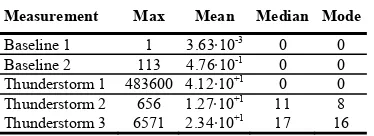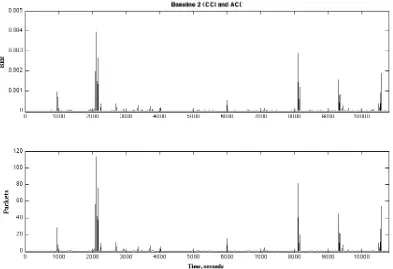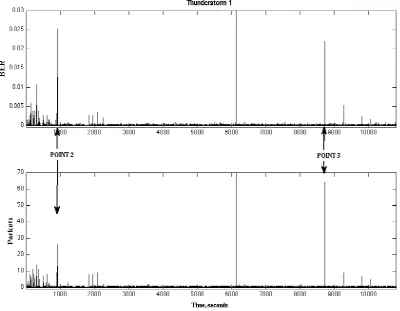Performance Analysis of Audio Streaming over
Lightning-interfered MIMO Channels
M.R. Bin Ahmad,
M.R. Mohd Esa, V. Cooray
Ångström Laboratory, Department of Engineering Sciences
Box 534, S-751 21, Uppsala University, Sweden
M.R. Bin Ahmad
Computer Engineering Department Universiti Teknikal Malaysia Melaka76100 Durian Tunggal Hang Tuah Jaya, Melaka
E. Dutkiewicz
Department of EngineeringMacquarie University, Sydney, Australia [email protected]
Abstract—This paper evaluates the interference from lightning flashes on the quality of audio streaming transmission over MIMO wireless system operating at 2.4 GHz. A consecutive lost datagram (CLD) measurement method was used to evaluate the transmission quality during 3 heavy thunderstorms on January 25, March 17, and March 20, 2011. In addition, CLD measurements also were done on January 21 and March 30, 2011 under fair weather (FW) conditions providing a baseline for comparison. We infer that lightning interfered with the transmitted digital pulses which resulted in a higher recorded number of lost packets per burst. We found the audio streaming quality is degraded significantly during all thunderstorms.
Keywords-audio transmission; MIMO; lightning interference; consecutive loss datagram.
I. INTRODUCTION
In the case of audio bit streams, lost packets may invalidate greater numbers of subsequent packets and lead to burst error. Packets that are lost generally cannot be recovered and they appear as momentary gaps during the transmission. A consistently high rate of lost packets is disturbing to human listeners. Even with a low overall average, if loss occurs in bursts, the quality of audio streaming suffers. As a result, lower values of packet error/lost rates must be maintained.
In general, a communication link for broadcast audio streams is recommended to maintain bit error rate (BER) below 1·10-3 [1] while for CD-quality broadcast compressed audio stream, the recommended BER value is below 1·10-4 [2]. A G.729 codec requires a packet error rate (PER) far less than 1·10-2 to avoid audible errors [1].
MIMO technology has demonstrated that reliable links could be maintained under the influence of man-made interference for various kinds of wireless networks [3,4]. However, interference due to natural sources could reduce the link reliability significantly. It could degrade the performance of all multiple antennas links at the same time. Common sources of interference due to natural phenomenon are lightning electromagnetic (EM) pulses and geomagnetically induced currents (GIC).
Lightning discharges produce EM radiation across the EM spectra. EM radiation for both ground and cloud flashes has been studied extensively in radio spectrum from 1 kHz to 1 GHz [5]. Ground flash only contributes a quarter of the total events of lightning discharge worldwide and cloud flash is believed to be the most common type of lightning discharge [6]. Sharma et al. [7] mentioned about the possibility of chains of cloud flash pulses interfering with the information sent through communication and data lines because the cloud flash pulses are similar to digitized communication pulse trains.
Esa et al. [8] investigated the effects of interference from laboratory sparks on a private mobile radio (PMR) communication link by observing the bit loss rate (BLR) at the UHF band. Laboratory sparks were created in two different series of measurements where in one case an impulse voltage generator (IVG) was used and in another case a recloser test set (RTS) was used. IVG produced sparks at breakdown voltages of 170kV and 400kV and RTS produced magnetic fields at discharge current peaks of 200A, 250A, 440A, 650A, 720A, 850A, 1500A and 2000A. In their experiment, where an impulse voltage was applied to create the spark all bits were received successfully without losses whereas 25 bits were lost for the high-current experiment at 440A, 850A and 2kA current peak values which corresponds to the BLR value of 2.5·102. Work done in [9] investigated the effects of interference from real lightning on SISO communication links at 2.4 GHz. A received signal strength indicator (RSSI) measurement method had been used with 1 meter LOS separation. These measured RSSI values were used to simulate BER for data, audio and video transmissions. It was concluded that lightning flashes reduce the received power and lead to unreliable communication links.
In this paper we present an analysis of maximum consecutive lost datagram (CLD) measurements at 2.4 GHz to evaluate the severity of the interference on the audio streaming transmission. The interference source was obtained directly from natural lightning and differs from laboratory sparks as in [8] and the BER values in our work were measured [10] and not simulated as in [9]. In addition previous work in [9] considered only SISO communication links at 2.4 GHz.
II. MEASUREMENT CAMPAIGN
A Dual-band Linksys WRT610N router [11] was connected through LAN cables to a laptop acting as a server. Another laptop acted as a client and was connected to the router wirelessly. A Dual-band Cisco WUSB600N wireless network card [12] was attached to the client laptop through USB interface. The router and the client laptop were equipped with three and two antennas respectively to realize multiple antennas technology. The router was connected to a power outlet available on the outer wall of an adjacent building and other devices were battery-powered.
The transmitting system (server laptop, router and antennas) was positioned on a wooden structure two meters above ground and the receiving system (client laptop, wireless network card and antennas) was positioned on a wooden structure half a meter above ground. Both the transmitting and receiving systems were covered from rain by a roof structure. The ‘ground’ in Figure 1 refers to Earth’s surface only. A ten meters distance separated the transmitting system from the receiving system. Both the transmitter and the receiver were operating either at 2.4 GHz. Adaptive modulations were chosen. Taking ten meters of LOS range into consideration, most probably 64-quadrature amplitude modulation (QAM) was fully utilized.
The application layer at the server of the transmitting system emulated a RealAudio application broadcasting audio content from a multimedia CD-ROM. The average sending data rate was 80 Kbps. The size of the audio data was 1 Mbytes. This data was transmitted using real time protocol (RTP) [13] over user datagram protocol/Internet protocol (UDP/IP). The payload type of the RTP was G.729 [14, 15]. The total overhead added to a single audio data packet was 40 bytes (from RTP, UDP and IP headers).
Five measurements were conducted on 21st January, 25th January, 17th March, 20th March, and 30th March. All the measurements were done in year 2011 at Universiti Teknikal Malaysia Melaka (UTeM) (latitude 2.313889oN, longitude 102.318333oE), Malacca, Malaysia.
Two measurements were carried out under fair weather (FW) on 21st January and 30th March which provide a baseline for comparison. FW measurements on 21st January were done under the influence of man-made interference with the existence of several adjacent channel interferers (ACIs) and co-channel interferers (CCIs). Several transmitters operated in the same band or the adjacent bands contributed to CCI or ACI interferences. The total run time for both FW measurements was 3 hours or 10800 seconds.
The other three measurements out of total seven measurements, on the other hand, were carried out during thunderstorms on 25th January, 17th March, and 20th March. The total run time for thunderstorm measurements was the same as FW measurements with the exception on 20th March. The total run time for 20th March was 130 minutes.
Both the transmitting and the receiving systems were set on start once heavy and dark thundercloud was observed and the both systems were set to off and the measurements were ended once the rain stopped. The total run time of the system experienced three different meteorological conditions namely thundercloud without rain, thundercloud with rain, and lightning flashes. The thundercloud without rain did always occur first followed by thundercloud with rain. Lightning flashes occurred during thundercloud with or without rain. At frequencies below 10 GHz, attenuation by atmospheric gases and rain may normally be neglected [16]. Therefore the communication links were affected by the thunderstorm alone.
III. PERFORMANCE ANALYSIS
Data collected from two reference measurements under fair weather conditions was used to analyze the performance of the MIMO links under thunderstorm conditions. As stated before, data during thunderstorm was recorded from three different thunderstorms at 2.4 GHz and the result of the analysis is presented here.
Table I shows the maximum and average values of the measured BER together with the information about the PER values measured at UDP layer. The FW measurements provide 3-hour BER and PER values during the normal or quiet period with the absence of thunderstorm. Table II shows the statistics of the measured maximum consecutive lost datagram (CLD).
Fig. 1 and 2 show the BER and maximum CLD plots of FW measurements done on 30th March 2011 (denoted as Baseline 1) and on 21st January 2011 (denoted as Baseline 2). The average BER value of Baseline 2 is ten times higher than the Baseline 1 value. The PER values for both measurements were low enough to avoid audible errors except at some peak points for Baseline 2 where the maximum CLD was significant, e.g. a burst of 113 packets was lost when recorded BER was peaked. The maximum CLD plots suggests no burst lost was occurred.
Fig. 3a shows the measured BER and maximum CLD during 25th January 2011 thunderstorm (denoted as Thunderstorm 1). Expanded scale is presented in Fig. 3b to provide clear plots of BER and maximum CLD values. The average BER value of Thunderstorm 1 is ten times higher than the Baseline 2 value and significantly higher than the recommended cap value [1]. The PER value was high enough to cause frequent audible errors. The maximum CLD plots suggests that a burst containing an average of 40 packets was frequently lost. Furthermore a burst containing 483600 packets was lost when recorded BER was peaked.
Table I. Statistics of the measured bit and packet errors.
Measurement Peak BER Mean BER PER
Baseline 1 4.0·10-4 1.27·10-6 0
Baseline 2 4.0·10-3 1.75·10-5 1.47·10-5
Thunderstorm 1 9.9·10-1 1.40·10-4 1.42·10-2
Thunderstorm 2 2.0·10-1 8.90·10-3 8.86·10-3
Thunderstorm 3 8.5·10-1 2.08·10-2 2.31·10-2
Table II. Statistics of the measured maximum consecutive lost packets.
Measurement Max Mean Median Mode
Baseline 1 1 3.63·10-3 0 0
Baseline 2 113 4.76·10-1 0 0
Thunderstorm 1 483600 4.12·10+1 0 0
Thunderstorm 2 656 1.27·10+1 11 8
Thunderstorm 3 6571 2.34·10+1 17 16
Fig. 5 shows the measured BER and maximum CLD during 20th March 2011 thunderstorm (denoted as Thunderstorm 3). The average BER and PER values of Thunderstorm 2 is higher than both of Thunderstorm 1 and 2 values but with lower recorded peak BER value compared to Thunderstorm 1. The maximum CLD plots suggests that a burst containing an average of 16 to 23 packets was frequently lost. Furthermore a burst containing 6571 packets was lost when recorded BER was peaked.
In summary the average number of lost packets per burst for all the thunderstorms were higher than for FW which ranging from 8 to 40 lost packets. Moreover the maximum number of lost packets per burst is significantly high during all thunderstorms.
IV. CONCLUSION
We evaluated the quality of an audio streaming over a MIMO communication system under thunderstorm conditions at 2.4 GHz. We found the audio streaming quality is degraded significantly during all thunderstorms. Our observations confirm the works in [8, 9] and also show that the MIMO communication systems can also be significantly interfered by thunderstorm operating at the studied microwave frequency.
ACKNOWLEDGMENT
We want to thank M. H. A. Aziz and M. Rashid for helping us conducted the measurement campaign in UTeM, Malaysia.
REFERENCES
[1] Chen Y, Farley T, and Ye N. QoS requirements of network applications
on the Internet. Journal Information-Knowledge-Systems Management 2004; 4: 55-76.
[2] Fluckiger F. Understanding networked multimedia: applications and
technology. Prentice Hall International (UK) Ltd., Hertfordshire, UK, 1995; pp. 242-382.
[3] Ahmad MR, Dutkiewicz E, Huang X, and Suaidi MK. Cooperative
MIMO systems in wireless sensor networks. Radio communications. InTech, 2010. Available at http://www.intechopen.com/books/radio-communications/cooperative-mimo-systems-in-wireless- sensor-networks.
[4] Taoka H, Higuchi K, Sawahashi M. Experiments on space diversity
effect in MIMO channel transmission with maximum data rate of
1 Gbps in downlink OFDM radio access. European Transactions on
Telecommunications 2006; 17: 611–622.
[5] Le Vine DM. Review of measurements of the RF spectrum of radiation
from lightning. Journal of Meteorology and Atmospheric Physics 1987; 37: 195-204.
[6] Rakov VA, Uman MA. Lightning physics and effects. Cambridge
University Press, UK, 2003; pp. 44.
[7] Sharma SR, Fernando M, Gomes C. Signatures of electric field pulses
generated by cloud flashes. Journal of Atmospheric and Solar-Terrestrial Physics 2005; 67: 413-422.
[8] Esa MRM, Sha'ameri AZ, Ahmad H, Malik NNNA. Conceptual
implementation to access the extend of influence of lightning electromagnetic radiation on mobile radio communication. Proceeding of Asia-Pacific Conference on Applied Electromagnetics 2005; 179– 183.
[9] Ahmad MR, Rashid M, Aziz MHA, Esa MM, Cooray V, Rahman M,
Dutkiewicz E. Analysis of lightning-induced transient in 2.4 GHz wireless communication system. Proceeding of IEEE International Conference on Space Science and Communication 2011; 225-230.
[10] Ahmad MR, Esa MRM, Rahman M, Cooray V. Measurement of BER at
2.4 GHz due to lightning interference. Proceedings of 2012 International Conference on Lightning Protection 2012.
[11] Dual-N Band Wireless Router Model WRT610N Datasheet. Available
at: http://homesupport.cisco.com/en-us/support/routers/WRT610N.
[12] Dual-Band Wireless-N USB Network Adapter Model WUSB600N
Datasheet. Available at: http://homesupport.cisco.com/en-us/wireless/lbc/WUSB600N/download.
[13] Schulzrinne H, Casner S, Frederick R, Jacobson V. RTP: A transport
protocol for real-time applications. IETF RFC 3550 Standard 2003. Available at: http://tools.ietf.org/html/rfc3550.
[14] Coding of speech at 8 kbit/s using conjugate-structure
algebraic-code-excited linear prediction (CS-ACELP). Recommendations ITU-T G.729, 2007. Available at: http://www.itu.int/rec/T-REC- G.729-200701-I/en.
[15] Implementors' guide for G.729 - (Coding of speech at 8 kbit/s using
CS-ACELP). Recommendation ITU-T G.Imp729, 2009. Available at: http://www.itu.int/rec/T-REC-G.Imp729- 200911-I/en.
[16] Propagation data and prediction methods required for the design of
earth-space telecommunication systems. Recommendation ITU-R
P.618-9, 2009. Available at: http://webs.uvigo.es/servicios/biblioteca/uit/rec/P/R-REC-P
Figure 1. Recorded BER and maximum consecutive lost datagram as measurement time elapsed on 30th March 2011.
Figure 3a. Recorded BER and maximum consecutive lost datagram as measurement time elapsed on 25th January 2011.
Figure 4. Recorded BER and maximum consecutive lost datagram as measurement time elapsed on 17th March 2011.



